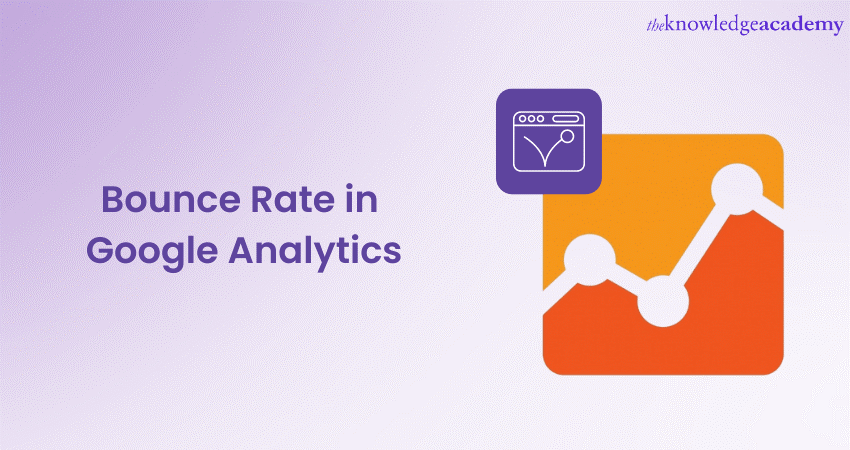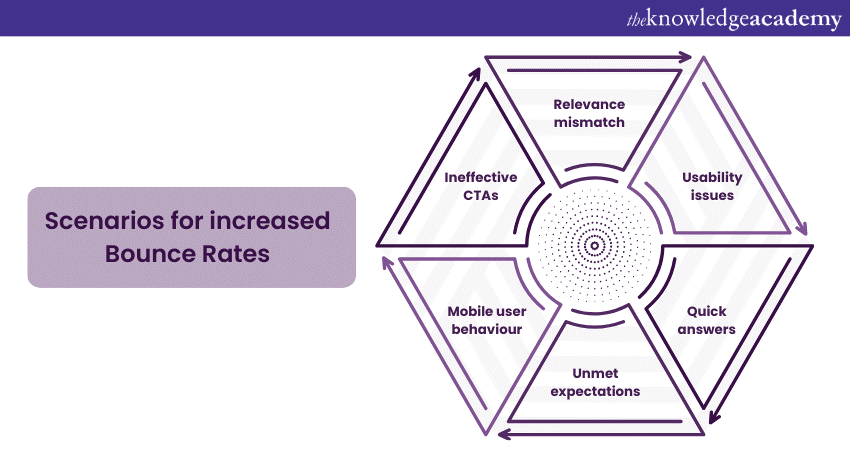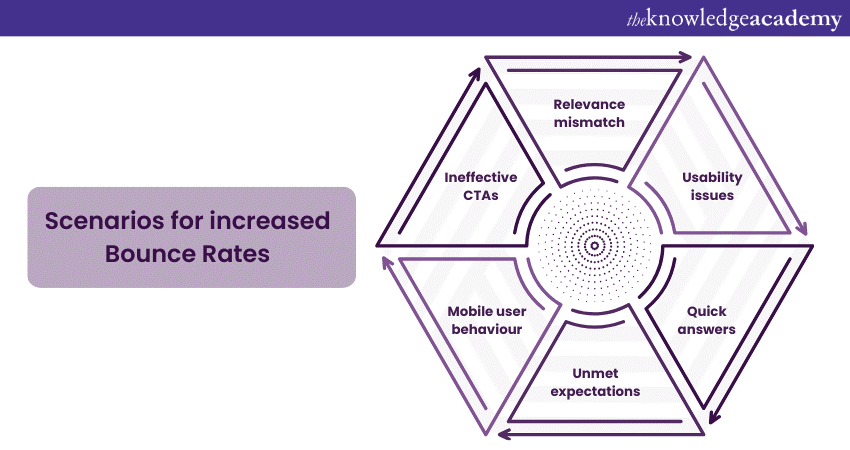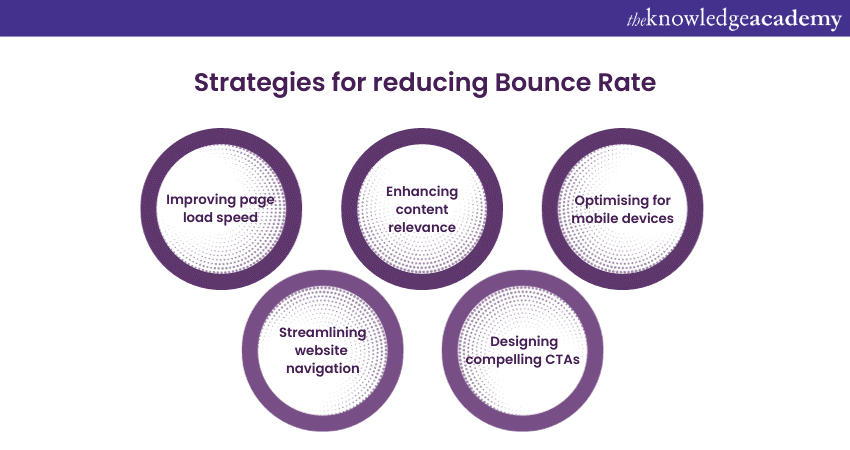We may not have the course you’re looking for. If you enquire or give us a call on +44 1344 203 999 and speak to our training experts, we may still be able to help with your training requirements.
Training Outcomes Within Your Budget!
We ensure quality, budget-alignment, and timely delivery by our expert instructors.

In the digital domain, understanding user engagement is critical, and that is where the concept of Bounce Rate steps into the spotlight, closely monitored through the lens of Google Analytics. This pivotal metric unveils the initial interactions between users and websites, providing insights into captivating design, compelling content, and seamless user experiences. The concept of Bounce Rate in Google Analytics, if understood well, can help Web Analysts frame the right strategies for user retention.
In this blog, we will try to understand what is Bounce Rate in Google Analytics, decipher its implications, and unveil strategies to master its dynamics.
Table of Contents
1) Introduction to Bounce Rate and its significance
2) How is Bounce Rate calculated in Google Analytics?
3) Understanding the factors influencing Bounce Rate
4) Interpreting Bounce Rate
5) Differentiating between good and bad Bounce Rates
6) Strategies for reducing Bounce Rate
7) Utilising Google Analytics to monitor Bounce Rate
8) Conclusion
Introduction to Bounce Rate and its significance
The definition of Bounce Rate in Google Analytics offers a panoramic view of how effectively your website captures and retains visitor interest. It's akin to a virtual first impression, providing valuable insights into user behaviour and interaction with your content. This metric tells a story of the immediate User Experience, reflecting whether your website managed to captivate, or left visitors disinterested.
Bounce Rate is not merely a numerical entity; it's a gateway to understanding user engagement. When visitors bounce off a page, it can signal various scenarios:

1) Relevance mismatch: The content must align with the visitor's expectations, leading to a swift departure.
2) Usability issues: Navigational complexities, slow-loading pages, or an unattractive design discouraged exploration.
3) Quick answers: A high Bounce Rate could signify that users immediately found the information they sought and didn't need to delve further.
4) Unmet expectations: Users will likely leave immediately if your page promises something enticing but needs delivery.
5) Mobile user behaviour: With the prevalence of mobile devices, users might quickly exit if the page isn't mobile-friendly.
6) Ineffective CTAs: A lack of clear Calls to Action might prompt visitors to abandon the page without interacting.
Unlock the power of Digital Marketing with expert guidance! Explore our Digital Marketing Courses today!
How is Bounce Rate calculated in Google Analytics?
In Web Analytics, a "Bounce" is recorded when a visitor lands on a webpage and exits without engaging in any further interactions. This means no clicks, scrolling, or navigating to other pages within your website. Instead of exploring, the visitor's journey ends abruptly, resembling the "Bounce" of a ball hitting a surface and quickly rebounding. The Bounce Rate is the percentage of single-interaction sessions over the total sessions on a particular webpage. Mathematically, it's expressed as:
Bounce Rate = (Number of Single-Interaction Sessions) / (Total Sessions) * 100
To accurately calculate the Bounce Rate, you need to grasp the concept of a session. A session represents a single visit to your website, encompassing the visitor's interactions during a specific time frame. Each session starts when a user lands on your site and concludes after a period of inactivity, typically 30 minutes.
In a single-page session, the visitor enters your website, views one page, and departs. Such sessions are crucial to calculating the Bounce Rate. If a visitor navigates to multiple pages within a session, it's not a bounce, as the user engaged beyond the landing page.
As a powerful tool, Google Analytics considers nuances to ensure accurate metrics. For instance, interactions like events (e.g., watching a video or clicking an external link) are considered engagement and prevent a session from being classified as a bounce. Similarly, if a user spends a substantial amount of time on the page, it might not be considered a Bounce, as their engagement indicates interest.
Understanding the factors influencing Bounce Rate
Bounce Rate, the digital equivalent of a fleeting first impression, reveals much about your website's effectiveness in retaining visitors. It's a crucial metric, but understanding its nuances requires dissecting the factors influencing it. From your website's design to your content's appeal, several components interplay to determine whether visitors linger or swiftly exit.

a) When users land on your website, its design and overall aesthetics greet them. Visitors might exit without exploring further if the plan is cluttered, overwhelming, or lacks visual appeal. A user-friendly interface, straightforward navigation, and an organised layout encourage engagement. A well-designed website invites users to delve deeper, increasing the chances of lower Bounce Rates.
b) When visitors arrive at your webpage, they seek answers or solutions. If your content fails to meet their expectations or address their needs, they're likely to Bounce. High-quality, engaging, and informative content keeps users glued and reduces the likelihood of an early exit. Understanding your target audience and curating content to their preferences is vital.
c) In instant gratification, page load speed can make or break user engagement. Slow-loading pages leads to impatience and frustration, causing visitors to abandon the ship before seeing your content. Optimising images, minimising unnecessary scripts, and leveraging Content Delivery Networks (CDNs) are tactics to accelerate load times and retain user interest.
d) With mobile devices dominating internet usage, your website's mobile responsiveness directly impacts Bounce Rates. If your site is optimised for various screen sizes, smartphone and tablet users might need help navigating, compelling them to bounce. Responsive design ensures your website adapts easily to multiple devices, offering a consistent and user-friendly experience.
e) A strategically placed and compelling Call to Action (CTA) can guide visitors further into your website's depths. Users might exit after consuming the initial content if CTAs are absent, unclear, or fail to captivate. Engaging CTAs prompts users to take specific actions, keeping them engaged and reducing Bounce Rates. A strong CTA provides direction, inviting users to explore more.
Take your analytics skills to the next level! Join our Google Analytics Masterclass now and unlock the secrets of data-driven success.
Interpreting Bounce Rate
As you navigate the landscape of Web Analytics, one metric looms large—the Bounce Rate. This percentage, indicating the proportion of users who leave a website viewing just one page, is a tantalising clue into user behaviour and engagement. But what do the numbers truly signify, and how can you glean valuable insights from them?
Bounce Rate, like any other metric, does not exist in isolation. It thrives in context. A blanket "good" or "bad" categorisation is not applicable because what's acceptable varies based on factors like your website's purpose, industry norms, and user intent.
Different pages serve different purposes, leading to varying Bounce Rate expectations. Blog posts might Bounce higher as readers come for specific information. On the flip side, landing pages designed to convert visitors into customers or leads should ideally have a lower Bounce Rate.
Understanding why visitors land on a specific page is crucial. Are they looking for quick answers, or are they seeking in-depth information? If users find what they need right away, they might Bounce, but that doesn't necessarily indicate failure—it's efficient engagement.
Patterns in Bounce Rates across different pages can reveal compelling insights. For instance, a consistently high Bounce Rate on a particular page might suggest issues with content relevance, design, or User Experience. Comparing Bounce Rates across periods can help you assess the impact of optimisations.
Differentiating between good and bad Bounce Rates
Bounce Rates are relative and deeply contextual. A high Bounce Rate doesn't necessarily spell disaster, nor does a low Bounce Rate guarantee success. The critical factor is aligning the Bounce Rate with the page's purpose. Consider the intent behind a user's visit and whether that intent was fulfilled. If visitors find what they need quickly—on a contact page with your phone number—the high Bounce Rate isn't a concern; it indicates efficiency.
Benchmarks provide a valuable compass for understanding your Bounce Rate's standing. What's considered high or low can differ significantly based on your industry. For instance, an e-commerce site might aim for a lower Bounce Rate on product pages, while a news website might have a higher Bounce Rate on news articles. Studying industry benchmarks offers a gauge for comparison and improvement.
Different types of pages warrant distinct Bounce Rate expectations. Blog posts might have higher Bounce Rates as visitors often seek specific information. On the contrary, landing pages intend to retain visitors and lead them toward conversion. A landing page with a high Bounce Rate could signal inefficacy in engaging users.
Understanding user intent is critical. If a visitor lands on a page seeking immediate information and finds it, a Bounce isn't necessarily negative—it could indicate the visitor's needs were met promptly. In contrast, a user exploring in-depth content or shopping for products might engage more before potentially bouncing.
Strive for the Goldilocks Zone—neither too high nor too low. A Bounce Rate that's just right for your specific context and goals is ideal. Continuously assessing and refining your website's User Experience, content relevance, and engagement strategies can help you reach that optimal range.
Ultimately, distinguishing between good and lousy Bounce Rates rests on finding an equilibrium between your website's objectives and user interactions. It's about understanding user behaviour, discerning when a bounce is a natural progression and when it's a sign of disengagement, and using this insight to navigate your website's growth.
Strategies for reducing Bounce Rate
Here’s a list of strategies that can be implemented to reduce Bounce Rates:

a) If your pages take too long to load, users might Bounce before getting a glimpse of your content. Optimise images, minify code, enable browser caching, and explore Content Delivery Networks (CDNs) to accelerate load times.
b) Content that fails to address user needs is a potent catalyst for Bouncing. Craft content with precision, focusing on relevance and value. Understand your audience's pain points, questions, and desires, then weave your content to provide solutions, answers, or insights. Engaging, informative, and targeted content encourages users to explore further.
c) Mobile devices have become the primary gateway to the digital world. If your website isn't responsive and doesn't offer a seamless experience across various screen sizes, you risk pushing mobile users to Bounce. Embrace responsive design, ensuring your website adapts elegantly to smartphones and tablets, captivating users regardless of their device.
d) Confusing navigation is akin to a labyrinth that users want to escape. A convoluted menu structure or a lack of clear pathways can lead to frustrated exits. Simplify navigation, making it intuitive and user-friendly. Users should effortlessly find what they seek, seamlessly moving between pages and sections.
e) A well-crafted Call to Action (CTA) can differentiate between a Bounce and a conversion. CTAs guide users toward the desired action—signing up, exploring more, or purchasing. Make CTAs prominent, action-oriented, and aligned with user intent. A clear and enticing CTA beckons users to stay engaged.
Utilising Google Analytics to monitor Bounce Rate
Here’s how you can utilise Google Analytics to monitor Bounce Rates:
a) Accessing Bounce Rate data is a pivotal step in unravelling the engagement dynamics of your website through the lens of Google Analytics. Log in to Google Analytics and select the specific property corresponding to your website; you can readily navigate to the "Audience" section.
b) The "Audience Overview" report shows the metric that speaks volumes—Bounce Rate—displayed as a percentage. This overview provides a comprehensive snapshot of the overall Bounce Rate for your website, enabling you to gauge the immediate engagement level of your visitors.
c) Setting up customised reports within Google Analytics offers a tailored lens through which you can glean nuanced insights into your website's performance. Upon entering the "Customisation" section, you can craft reports that align precisely with your analytical goals. By selecting "+ New Custom Report," you initiate a customisation journey.
d) This journey entails assigning a meaningful name to your report and configuring the metrics that matter most to your analysis. Incorporating dimensions like page titles, traffic sources, or user demographics allows you to delve deeper into specific aspects of your Bounce Rate.
e) Analytics lets you discern which traffic sources contribute to your Bounce Rate. Do visitors from social media platforms tend to bounce more than those from organic searches? These insights empower you to refine your targeting and engagement strategies for different audience segments.
f) Google Analytics also enables time-based analysis. You can ascertain if specific periods witness higher Bounce Rates. This could indicate seasonality, campaign effectiveness, or changes in user behaviour over time.
g) The beauty of Google Analytics lies in its iterative nature. You can implement changes and monitor their impact over time as you analyse Bounce Rate data. This cycle of analysis and refinement becomes the driving force behind continual improvement.
h) Google Analytics is more than a tool—it's a compass guiding your website's evolution. By accessing Bounce Rate data, customising reports, unveiling user behaviour patterns, and identifying traffic sources, you're empowered to transform insights into action. Armed with these insights, you can embark on a journey to enhance user engagement, lower Bounce Rates, and sculpt a more captivating digital experience.
Conclusion
As the digital domain grows, mastering the nuances of Bounce Rate in Google Analytics remains an integral skill for web admins and marketers. Armed with a deeper understanding of this metric's significance and the tools to shape it, one can harness user behaviour insights to craft user-centric websites that captivate, engage, and ultimately drive meaningful conversions. By weaving together design finesse, content relevance, and strategic navigation, we journey toward transforming Bounce Rates into stepping stones to a more compelling online space.
Frequently Asked Questions
Upcoming Digital Marketing Resources Batches & Dates
Date
 Digital Marketing Course
Digital Marketing Course
Fri 24th Jan 2025
Fri 28th Mar 2025
Fri 23rd May 2025
Fri 25th Jul 2025
Fri 26th Sep 2025
Fri 28th Nov 2025







 Top Rated Course
Top Rated Course



 If you wish to make any changes to your course, please
If you wish to make any changes to your course, please


